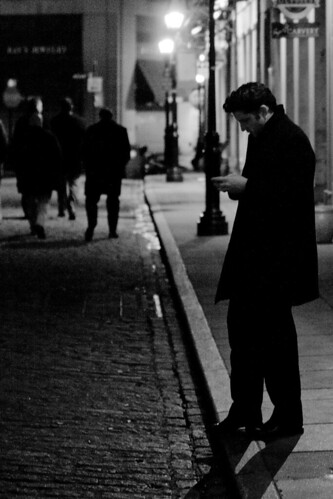But did I cheat to get this result? Yesterday, the World Press Photo disqualified one of the winners from this year's contest. This gave me pause. In order to get the result above, I tampered with the original--both with exposure levels and through cropping.
Read on to see my original image, the World Press Photo and for some more thoughts on the topic.
Here's the photo as I shot it:
The two images are very different in feel and composition. Now, do those difference make my alterations wrong--did I cheat my audience in some way? I think not. After all, a photograph, like a drawing or painting, is not reality but merely an image of reality. I could have shot in black and white, used a lens with a longer focal length, and perhaps shot in film to achieve the outcome I eventually produced through digital alterations. Despite the changes, the final result still captures an actual moment on a New York street. And I am definitely not alone in finding cropping acceptable. Ansel Adams, Walker Evans, and Man Ray, to name a few, were all known to crop their photos.
If some retouching is justifiable, then that begs the question of when alterations go too far. It seems to me that this would depend on the context of the photo. A photojournalist should probably be held to higher standards, than a fine arts photographer. Informed by the context, a viewer of a photograph will have different expectations as to how close an image is to reality. In light of this, I did not find it surprising that the World Press Photo disqualified the following photo:
![]()
The photograph in questions is cropped and retouched from this:
![]()
I am curious to hear what other people think about this. Did I go too far in altering my photo? Should the prize winning photo have been disqualified?
(Hat tip: PetaPixel)


I'm a photojournalist, and I don't think you went too far at all with your photo. But perhaps it's not the greatest photo to compare to the other one. Firstly, yours is not "photojournalism", which as you said, should be held to higher standards in order to assure that people can trust the medium and the photographers. Secondly, you took a poor exposure (underexposed) and brought it up a fair amount. He took a well exposed but relatively boring frame, cropped in immensely, burnt in all the edges to create a vignette effect, heavily adjusted contrast, and maybe even added grain to give it a B+W feel. Then he cropped out a foot, which is 100% no-no in the journalism world, as it rightfully should be. You just toned your photo, perhaps a little heavily. He drastically altered it both in content and context. Lastly, I don't even think his photo is good, and the series it was part of--(which won the prize, not this image alone)--is no better. It was very repetitive, over-toned, and boring--especially considering the subject matter, which is very interesting.
ReplyDeleteThanks for the feedback. I can see why cropping anything out of a photo is not acceptable in photojournalism. But the greater sin in the disqualified photo (and probably the entire series) seemed to me to be altered contrast, vignetting, and so on. So it was surprising to me that the photo might not have been disqualified if the photographer had stopped short of removing the foot.
ReplyDeleteJens, I am of the same opinion as you related to the concern of overall change of an event in the Word Press disqualified photo. However, the alterations to your photo and the issue of cropping are a very different issue for me. And that is the bridge between creative arts such as painting drawing and even collage and digital photography. When using a film camera I didn't have the luxury of cropping as I didn't do my own developing. Hence my digital photos usually require little cropping as well - but sometimes there is just a better image inside an image. I am not sure there is a line to cross unless we create one. And should we? redbubble where I post my photos is absolutely riddled with altered images. After awhile you have to put a comment to say "straight from the camera." I have been pondering this issue for awhile and still have not settled on an easy answer. Thanks for your great post on the subject. Terrill Welch
ReplyDeleteHello Pam,
ReplyDeleteI quoted your article and link in my travelogue post.
http://www.rishiray.com/2010/04/02/the-huge-lie-of-adobe-photoshop-in-travel-photography/
I'll just say that we can agree to disagree :)
Rishi